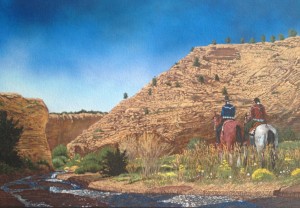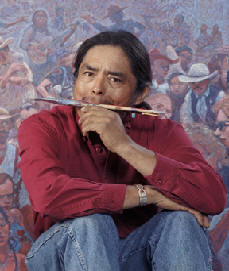 As late spring rolls out its verdant carpet for summer’s entrance, I will once again step into its promise of the season’s fullness and festivities. This is the promise I yearned for as a child.
As late spring rolls out its verdant carpet for summer’s entrance, I will once again step into its promise of the season’s fullness and festivities. This is the promise I yearned for as a child.
It is called Shii’ in Navajo (Summer)—The Time When Late Snow Showers and Thunderstorms Mingle. The late storm we call Aye’he ne’dinni’yoodi (Chasing Away the In-laws)—When the Young Suitor Runs Home to the Comfort of His Own Mother’s Hoghaan. It is followed by carpets of bright and cheery wildflowers that will only wither with the summer’s heat. We call this Shii’ y’naal dziidi’ (Frightened by Summer).
In my community of Shonto, Ariz., summer’s entrance is announced by an event we know as Rock the Canyon. This rocking of the canyon is now in its seventh year and has inspired other communities on the Rez to have their own celebration. Our community governing board some years ago decided that one of the ways to help our youth pursue their dreams and attain their goals was to bring local artists that had made a name for themselves in their profession back into the community. This was a way to tell the young people, “Yes we are from here and were raised on the same dirt roads. The same geography that molded and inspired us can empower you. You can make it too.” It is always a good idea to give youth a boost in these remote areas of the Rez.
Seven years ago I was the first artist to be given that honor. To receive that validation from your community is a powerful measure of success. Since that time, there have been five more honorees including my younger brother Anthony, whose work, Shonto Canyon, accompanies this column. Shonto’s community has produced some of the finest artists working in all media, and one has to only look at the surrounding countryside to see why. Renowned visionaries like my older clan brother Baje Whitethorne Sr., and my cousins John Bahe Smith, Allan Bahe and others, took inspiration from this landscape. I have been living away from my community of birth for some years now, although I do return often. The community—or in the geopolitical term, Chapter of Shonto—is beautiful and picturesque, bi-sected by a canyon with 300-foot walls of Navajo and Moencopi sandstone that runs southwesterly from the labyrinth of the Tsegi Canyon system and splays out 20 or more miles into the sandy and shallow depression of the Cow Springs alluvial flats. Shonto is a community of people that knows each other by traditional names and clan systems. It includes the pinyon and juniper pygmy forest interspersed with sage flats and water-pocketed slick rock outcroppings and stretches into the saltbush and snakeweed sand dunes. To the east of our community looms Dzilli’Jiin (Black Mesa) or Mother’s Body. To the north stands Naa’sis san (Navajo Mountain) or The Head of The Mother.
This is a good place to be raised. It is also a harsh place to grow up. Today jobs are still scarce and there are few opportunities for young people to remain. The support and effort of the community turned the dream of giving a dose of confidence and pride to the younger generation into a reality. For that reason alone I will be there again this year when another young artist, Delvin Slick, is our honoree. I urge and encourage your presence on Sat, June 6 when the Seventh annual Rock the Canyon event will be held under the giant cottonwood trees on the canyon floor across from the Trading Post. In 2008 I was informed that honor was mine and I could not have been more humbled. I did not quite know what to expect. I stepped up to that sandy plate. My community came out in droves. We love a celebration of any kind—any opportunity to reaffirm the elders. All of us were standing beneath the light shimmering off the fluttering cottonwood leaves which were giving everything a vibrant energy, like the light shining off the laughing faces as the great James Bilagody, a clan brother, punctuated his speech with laughter.
With the assistance of my daughters we set up under the shade. Shonto Canyon rang with the sound of smiles. The ravens and pinyon jays gathered somewhere above us unseen. It was a beautiful day to celebrate one another. I sang the first song, a love song to my community. I sang in the unique and beautiful Dineh accent, “If you walk close to me, my heart will go skippity skip. But if you hold my hand, my soul goes hippity hop …”
It proves to be a way back into the familiarity of my own past. Elders with powerful names, elders with powerful hands, elders with knowledge our political leaders can only scratch at best. I felt this was a true meaning of a community’s heart. To my contemporaries I shared the horror of boarding school, to the ones in diapers beaming their acceptance it offered an opportunity to shine, to put action into my mantra: Art saves lives!
A full day of music, great performances, reaching the best of our potential, and the mutton sandwich awaits you. It is a winning combination.
I end up giving most of my art prints to the community except for those bought by a few wonderful Swedes after I gave my Xhaa’ne’ (Story). I saw the smiles. It gives one hope. It gives juice to the spiritual muscles. A day in a community’s life given over to build our new generation.

